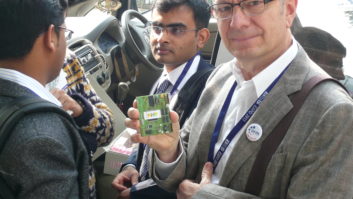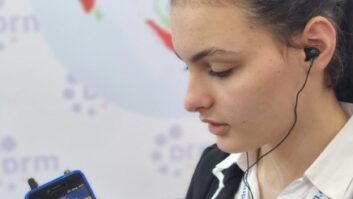Meanwhile, TokyoFM Develops Unique Metadata Model
U.S. broadcasters face some daunting challenges as they consider how to build their businesses with HD Radio technology. The needs of the digital transition go far beyond the transmitter site, requiring changes in audio production and distribution, data management, quality control, scheduling, promotion and marketing, to name but a few.
As these challenges loom large in the coming months and years, it is helpful to step back for an overview of developments in the worldwide adoption of digital radio.
Three prominent members of the international radio community had an opportunity at NAB2004 in Las Vegas to present their views on the digital transition and offer insights on the introduction of digital broadcast technologies to consumer markets.
Dr. Donald Messer, director of the spectrum management division for the U.S. International Broadcasting Bureau/Voice of America, is bullish on the future of the Digital Radio Mondiale system for digital AM broadcasting on bands below 30 MHz. In recent tests his agency conducted on several medium-wave installations in Europe, Messer said the system proved itself capable of equivalent coverage to analog, with significantly lower transmitter power and substantially improved audio quality.
No interference noise
One dramatic example of the system’s advantages can be seen in the tests conducted at a VOA facility in southeastern England that operates on 1296 kHz with 250 kilowatts of analog power. Along a 500-mile path to a location in Germany, coverage was equivalent with only 70 kilowatts of power for the DRM signal; and the received audio approached FM quality, with none of the interference noise associated with analog reception.
Messer said this power advantage is realized primarily because the field strength required for reception of unimpaired digital signals is so much lower than what is needed to receive barely intelligible analog signals.
Now that DRM is approved by the International Telecommunications Union for use in Regions 1 and 3 – essentially everywhere except North and South America – and more than 50 broadcasters have begun regular DRM service, the biggest challenge is increasing receiver penetration.
Current early-generation DRM receivers remain relatively expensive, but Messer expects the market will see receivers later this year selling in the 100-200 Euro range, or about $125 to $145. An inexpensive interim solution to the receiver problem popular among DX and shortwave hobbyists is a PC-based software radio. Although this may quell some of the early demand, it will take time before DRM receivers are adopted widely.
Philip Laven, technical director for the European Broadcasting Union, knows this all too well. Commercial Eureka-147 DAB receivers were introduced six years ago, but adoption of the technology by consumers has been largely stalled since, he said.
Recently, the outlook has brightened with the success of DAB in the United Kingdom. Sales of receivers there have taken off, and interest in digital radio is high among British consumers.
Laven credits several small receiver manufacturers with breaking the impasse by introducing low-cost DAB receivers last year, driving DAB receiver penetration in the U.K. past 400,000 by the end of 2003. Their success has not gone unnoticed, he said, and “the big manufacturers are now following.” With this surge of interest and related marketing muscle, total sales of receivers in the United Kingdom are expected to pass 1 million units by the end of 2004, Laven said.
The biggest driver of DAB adoption in the U.K., however, is neither receiver availability nor the much-touted improvements in audio quality and reception. It’s programming.
Content is paramount
“Technical quality is important, but content is more important,” Laven said.
The two U.K. national digital broadcast networks, BBC and DigitalOne, offer not only simulcasts of existing analog services but also new digital-only channels. Many other local services are being launched only on DAB to complement the national offerings.
It’s a model that Laven and others in the DAB community hope can be replicated and applied in other countries to jumpstart lagging sales of receivers. As one example, Danish broadcaster DR is offering eight new national radio services, broadcast only on DAB, according to Laven.
This is one lesson U.S. broadcasters may need to learn for HD Radio to flourish: promises of improved audio quality and the whiz-bang factor of new technology can only go so far in convincing consumers to purchase a new receiver. “Attractive content is the key driver for the success of any digital radio service,” Laven said.
Managing this content is perhaps the greatest challenge broadcasters face in moving to digital broadcasting. Along with the audio, stations must now be just as vigilant about ensuring that the correct program-associated data such as artist and title information is broadcast at the right time.
Additional metadata, such as program airdates and times, host information, artist biographies, photos, and graphics, must be managed and linked to the audio and PAD so that on-demand audio archives on station Web sites can be kept current.
WAP servers, PDA playlist downloads and traffic systems need to be synchronized. And that’s just for the primary channel.
Metadata model
In Japan, where digital radio has long been seen as just another distribution method for digital audio content already widely available through cable, satellite, mobile telephone and broadband Internet, broadcasters have been grappling with the complexities of managing all of the data needed to repurpose content on varied distribution platforms.
Shigeru Aoki, the research and development engineer for TokyoFM Broadcasting, has developed a new metadata model that encompasses the data needed for production, asset management and distribution.
The format is designed to accommodate schedule information for electronic program guides for existing cable and satellite distribution, as well as the new Integrated Services for Digital Broadcasting system for over-the-air Terrestrial Sound Broadcasting (ISDB-T SB). The model also is capable of managing the metadata for a proposed on-demand music-ordering/download service.
For audio production, Aoki envisions all low-level metadata (audio format, bit depth, frequency, production notes, cue points, etc.) embedded in the header of the audio file itself. This allows the information to be linked with the audio in a digital audio workstation at the point of creation and ensures that this critical information does not become separated from the audio.












